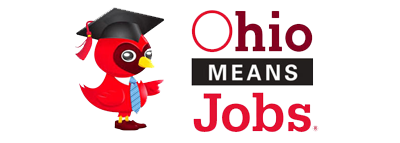
Ohio Employment First Transition Framework
The Ohio Employment First Transition Framework is a results-oriented transition process that was developed with a team of statewide stakeholders to provide a common approach for transition planning and service delivery across all systems that serve transition-age youth. It was built on foundational elements that are person-centered, agency neutral, and outcome focused. The framework is not a procedure, form, or service; it is a process that includes tools which have been developed to facilitate planning and service delivery for effective Transition Planning.
The Ohio Employment First Transition Framework page offers the tools listed below to aid in student transition.
Agency Navigation Tool
Youth, families, and transition teams can encounter a variety of partner agencies offer support, services, and resources to assist the youth along the path to employment. This exploration can be overwhelming. The Agency Navigation Tool is a multi-agency overview that can assist team members with planning and organizing.
Backward Planning Tools
The Backward Planning Tools provide youth the opportunity to focus first on their adult outcomes, then plan back from the end goal to the present in order to define a logical sequence of actions. This helps to provide the youth with the instruction and experiences to achieve their desired outcomes. We recommend using the Introductory Video for the Backwards Planning Tools for help in their use.
Evidence Based Practices & Predictors for Transition Youth
Evidence Based Practices and Predictors are research-based strategies that focus on transition youth. These practices and predictors provide guidance to develop and improve youth skills for community employment and participation, and are useful to transition professionals across systems and in multiple environments.
Making My Way through College
Making My Way Through College is a guide for any student pursuing a degree or other type of credential at a two-year or four-year community college, college, or university. The guide offers information on a variety of topics relevant to preparing for and succeeding in college and transitioning from college into the world of work.
Much of the information provided is relevant to all students, but the primary focus of the guide is on navigating the college experience for students with disabilities or those who think they may have a disability. The guide is written by the National Collaborative on Workforce and Disability for Youth (NCWD/Youth) and available through Ohio Employment First.
Path from School to Employment Folder
The Pathway from School to Employment shares an timeline that can serve, at minimum, as a very practical conversation starter with families and youth regarding the expectations, questions, services, and decisions that need to be considered during the years of transition planning. An introductory video of Employment First Transition Framework Resource Tools is also available.
Profiles of Ohio’s Postsecondary Programs for Students with Intellectual and Developmental Disabilities
Ohio’s Postsecondary Programs for Students with Intellectual and Developmental Disabilities deliver inclusive college experiences for students with intellectual and developmental disabilities (IDD) that include internships, college classes, housing, and social experiences that result in improved access to gainful employment.
Transition Assessment Planning Guide
The Transition Assessment Planning Guide assists multi-agency teams work together to plan the assessment activities that will result in meaningful, individualized, and important data. This collaboration results in a co-planned transition assessment which eliminates duplication of assessment efforts, and ensures each agency gets the data and information they require. The introductory video for the Transition Assessment Team Planning Guide is available for support.
Vocabulary Crosswalk
Transition teams consistently identify poor communication as a barrier to collaboration and successful transition planning among multi-agency teams. Agency words and terms can lead to misunderstanding, limit discussions, and prevent collaboration. The Vocabulary Crosswalk is a reference tool that can be consulted to clarify confusing vocabulary.
This page was updated August 16, 2021
OhioMeansJobs K-12
OhioMeansJobs K-12 is Ohio’s no-cost, career planning system that offers comprehensive, career exploration tools, online training, and resources specifically for students, teachers, and school counselors. Ohio Means Jobs allows students to learn more about their career interests and in-demand jobs, build resumes, search for college and training programs, create a budget based on future expenses, and develop meaningful academic and career plans for high school and beyond.
Through this comprehensive online system, students can register, create resumes, search jobs, plan, find funding, and explore college and career options. Students can locate job fairs and workshops, search occupations, find Ohio-based employment programs and scholarships, and practice interviewing for a job.
OhioMeansJobs
OhioMeansJobs is an online job matching system that connects employers and job seekers. The site has a regional search feature that enables the user to find in-demand occupations, job posting trends, and resources for learning about career planning, and job searching.
OhioMeansJobs Centers
OhioMeansJobs Centers assist job seekers, employers, and youth with job search assistance, employee recruitment, job training, and more.
This page was updated January 26, 2021
 Competitive Integrated Employment Toolkit
Competitive Integrated Employment Toolkit
The National Technical Assistance Center on Transition (NTACT) developed the Competitive Integrated Employment Toolkit as a resource for educational and vocational rehabilitation agencies to improve post school employment outcomes for students with disabilities. The toolkit facilitates collaboration for implementing secondary transition services across agencies at the state, community, and student levels, and increases the use of evidence based practices. It is also a framework to assist state and local teams in collaboratively implementing transition services to improve post school employment outcomes for students with disabilities.
Editorial note: The toolkit functions best when users create a login for access to all of the available resources.
New Job Portal: OOD Works
Opportunities for Ohioans with Disabilities or OOD launched a new job portal, OODWorks. The site allows potential consumers to learn about OOD’s Vocational Rehabilitation (VR) services and complete an online application. This provides a more streamlined process in their pursuit of employment. Individuals interested in VR services are encouraged to visit the portal where they can watch an orientation video about the employment process, take a brief self-assessment and apply online.
Resume and Employment Guide for People with Disabilities
According to the Social Security Administration, there are over 8 million disabled workers in the United States. These workers often face challenges such as stereotyping, discrimination, and a lack of accommodations. Thankfully, there are a variety of legal protections and employment resources available that help people with disabilities overcome these challenges and advance their careers. Resume Builder has a guide for people with disabilities that displays the best practices for resume writing, laws that protect you from discrimination, and several other topics that you should know about as a disabled worker.
Success in the New Economy
Citrus College supported the production of Success in the New Economy a video designed to help a broader audience begin to understand preparation today for tomorrow’s labor market realities and how four-year college/university programs do not automatically equate to higher-paying employment or “better jobs.” The end result is a compelling case for students to explore career choices early, make informed decisions when declaring their college education goal, and to consider technical skill acquisition, real-world application, and academics (career technical programs) in tandem with a classic education. This balanced approach to life and learning results in a well-educated and employed workforce.
- Updated 2018 Version: Success in the New Economy – FutureBuilt
A Transition Guide to Postsecondary Education & Employment for Students & Youth with Disabilities
A Transition Guide to Postsecondary Education and Employment for Students and Youth with Disabilities is designed to help youth with disabilities to achieve their post-school and career goals and ensure that they are equipped with the skills and knowledge to be engaged in the 21st Century workforce. This guide addresses transition planning opportunities and programs, services and requirements, and education and employment options for students and youth with disabilities after leaving secondary school and supports decisions made by students and youth with disabilities. It includes real life examples, a sample flow chart of the transition process, and a glossary of key terms used in the transition process.
Day at Work Videos
Curated and shared by ConnectEd, this collection of Day at Work videos to help youth better understand the rapidly changing world of work, and the skills needed to be successful in the 21st century. Videos can be sorted by Industry and average approximately 3 minutes in length each.
Q & A on Customized Employment for People with Physical Disabilities
The Q & A on Customized Employment for People with Physical Disabilities fact sheets provide answers to questions to consider when evaluating employment possibilities and holding discussions with employers about customized employment for people with physical disabilities. This source was created by the Virginia Commonwealth University, Rehabilitation Research and Training Center on Employment of People with Physical Disabilities (VCU-RRTC).
This page was updated July 29, 2021
- An Employment Planning Guide for Families of Young Adults with Intellectual Disabilities
- Community Investment Tool and Investment Tool Guidance Document
- Competitive Integrated Employment Toolkit
- Employment First Transition Framework Resource Tools
- Evidence Based Predictors for Transition Youth
- Making My Way through College Resources and Planning Guide
- New Job Portal: OOD Works
- Ohio Employment First Transition Framework | introductory video
- Ohio Employment First Agency Navigation Tool
- OhioMeansJobs | Search WorkKeys | Regional Search
- OhioMeansJobs K-12
- Pathway from School to Employment
- Profiles of Ohio’s Postsecondary Programs for Students with Intellectual and Developmental Disabilities
- Success in the New Economy (video)
- Transition Assessment Team Planning Guide | introductory video
- Q & A on Customized Employment for People with Physical Disabilities
- Vocabulary Crosswalk
Backwards Planning Tool
Please note: This list contains one external link and one Zip file. Zip files are downloaded and must be extracted to view. The files can be extracted with a free, open source software program like PeaZip.
This page was updated December 3, 2019

